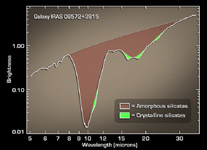
Click on image for larger graphThis artist's concept shows delicate greenish crystals sprinkled throughout the violent core of a pair of colliding galaxies. The white spots represent a thriving population of stars of all sizes and ages. NASA's Spitzer Space Telescope detected more than 20 bright and dusty galactic mergers like the one depicted here, all teeming with the tiny gem-like crystals.
When galaxies collide, they trigger the birth of large numbers of massive stars. Astronomers believe these blazing hot stars act like furnaces to produce silicate crystals in the same way that glass is made from sand. The stars probably shed the crystals as they age, and as they blow apart in supernovae explosions.
At the same time the crystals are being churned out, they are also being destroyed. Fast-moving particles from supernova blasts easily convert silicates crystals back to their amorphous, or shapeless, form.
How is Spitzer seeing the crystals if they are rapidly disappearing? Astronomers say that, for a short period of time at the beginning of galactic mergers, massive stars might be producing silicate crystals faster than they are eliminating them. When our own galaxy merges with the Andromeda galaxy in a few billion years, a similar burst of massive stars and silicate crystals might occur.
Crystal Storm in Distant Galaxy
The graph (see inset above) of infrared data from NASA's Spitzer Space Telescope tells astronomers that a distant galaxy called IRAS 08752+3915 is experiencing a storm of tiny crystals made up of silicates. The crystals are similar to the glass-like grains of sand found on Earth's many beaches.
The data were taken by Spitzer's infrared spectrograph, which splits light open to reveal its rainbow-like components. The resulting spectrum shown here reveals the signatures of both crystalline (green) and non-crystalline (brown) silicates.
Spitzer detected the same crystals in 20 additional galaxies, all belonging to a class called ultraluminous infrared galaxies. These extremely bright and dusty galaxies usually consist of two galaxies in the process of smashing into each other. Astronomers believe massive stars at the hearts of the galaxies are churning out clouds of silicate crystals. This phenomenon may represent a short-lived phase in the evolution of galactic mergers.

